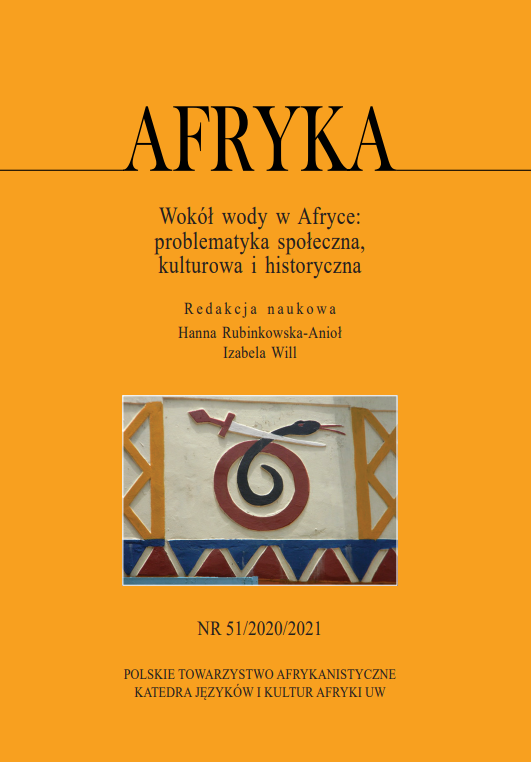Abstract
The paper presents selected issues related to the surface waters of continental Africa. In the first part, the main rivers, lakes, wetlands, and dam reservoirs are characterized, and the second outlines their importance for agriculture, fisheries, and inland waterways. The data were taken from the literature, the FAO statistical yearbook and the Aquastat, World Waterfalls Database, and Global Lakes and Wetlands Database. Africa has the world’s largest river systems (Nile, Congo), one of the world’s largest lakes (Lake Victoria, Tanganyika), the world’s largest wetlands (Sudd, Okavango delta, Niger inner delta), and dam reservoirs that are among the largest in the world (Volta on the Volta River and Kariba on the Zambezi). However, water resources are unevenly distributed and dependent on exceptional variability in precipitation in the short and long term. Next to the regions with vast irrigation possibilities and the development of fisheries and inland waterways, Africa has regions with drastically low surface water resources. Climate change, combined with a growing population, will deepen the disparities.
References
- Alsdorf, Douglas et al. 2016. „Opportunities for hydrologic research in the Congo Basin”. Reviews of Geophysics 54, 378–409.
- Avery, Sean. 2018. „How Ethiopia and Kenya have put a world heritage site in danger”. The Conservation UK, July 8.
- Baijot, Etienne; Jaques Moreau; Sana Bouda. 1997. Hydrobiological aspects of fisheries in small reservoirs in the Sahel region. Wageningen: Technical Centre for Agricultural and Rural Cooperation.
- Barakagira, Alex; Anton H. de Wit. 2019. „The role of wetland management agencies within the local community in the conservation of wetlands in Uganda”. Environmental & Socio-economic Studies 7, 1, 59–74.
- Beilfuss, Richard; David dos Santos. 2001. „Patterns of hydrological change in the Zambezi delta, Mozambique”. Program for the sustainable management of Cahora Bassa Dam and the Lower Zambezi Valley. Working Paper 2, 1–152.
- Bonnerjee, Sobhanlal et al. 2009. Inland waterborne transport: Connecting countries. Paris: United Nations Educational, Scientific and Cultural Organization, UNESCO.
- Bourma, Arrakhais A. et al. 2017. „Contribution to knowledge of the Lakes of Ounianga by bathymetry and physicochemistry”. International Journal of Water Resources and Environmental Engineering 9, 10, 218–225.
- Chudzik, Patryk; Mateusz Żmudziński. 2017. „Rola Nilu w kształtowaniu kultury starożytnego Egiptu”. Prace Kulturoznawcze 21, 3, 13–25.
- Coe, Michael T.; Jonathan A. Foley. 2011. „Human and natural impacts on the water resources of the Lake Chad Basin”. Journal of Geophysical Research 106, D4, 3349–3356.
- Czeppe, Zdzisław; Jan Flis; Rodion Mochnacki. 1969. Geografia fizyczna świata. Warszawa: Państwowe Wydawnictwo Naukowe.
- FAO. 2017. AQUASTAT Main Database. Food and Agriculture Organization of the United Nations (FAO).
- FAO. 2020. World food and agriculture – Statistical Yearbook 2020. Rome.
- Funge-Smith, Simon. 2018. „Review of the state of the world fishery resources: Inland fisheries”. Fisheries and Aquaculture, FAO Circular, C942, Revision 3.
- Geheb, Kim et al. 2008. „Nile perch and the hungry of Lake Victoria: Gender, status and food in an East African fishery”. Food Policy 33, 85–98.
- Goudie, Andrew S. 2005. „The drainage of Africa since the Cretaceous”. Geomorphology 67, 437–456.
- Kite, G.W. 1981. „Recent changes in level of Lake Victoria”. Hydrological Sciences Journal 26, 3, 233–243.
- Kröpelin, Stefan. 2009. „Lakes in the Sahara”. German Research 2, 9.
- Makowski, Jerzy. 2006. Geografia fizyczna świata. Warszawa: Wydawnictwo Naukowe PWN.
- Mydel, Rajmund; Jerzy Groch, (red.). 1998. Przeglądowy atlas świata. Afryka. Kraków: Fogra Oficyna Wydawnicza.
- Nicholson, Sharon. 2000. „The nature of rainfall variability over Africa on time scales of decades to millennia”. Global and Planetary Change 26, 1, 137–158.
- Orange River. 2020. https://en.wikipedia.org/wiki/Orange_River, dostęp z dnia 15 września 2020.
- Osuagwu, Eze S.; Eseoghene Olaifa. 2018. „Effects of oil spills on fish production in the Niger Delta”. PloS One 13, 10, e0205114.
- Ramsar Convention. 1971. „Convention on wetlands of international importance especially as waterfowl habitat”. Ramsar, Iran, 1–6.
- Ramsar List. 2020. The List of wetlands of international importance.
- Rebelo, Lisa-Maria; Asim I. El Moghraby. 2018. „The Sudd (South Sudan)”, w: C.M. Finlayson et al. (red.), The wetland book. Dordrecht: pringer, 1299–1306.
- State of the River Nile Basin. 2012. Entebbe: Nile Basin Intitative.
- Sutcliffe, John; Emma Brown. 2018. „Water losses from the Sudd”. Hydrological Sciences Journal 63, 4, 527–541.
- Termiński, Bogumił. 2013. „Wysiedlenia inwestycyjne: przyczyny, konsekwencje i kontekst prawny”. Revista Europea de Derecho de la Navegación Marítima y Aeronáutica 30, 79–118.
- UNEP. 2010. Africa water atlas. Nairobi: Division of Early Warning and Assessment (DEWA). United Nations Environment Programme (UNEP).
- Volta River. 2020. https://en.wikipedia.org/wiki/Volta_River, dostęp z dnia 15 września 2020.
- Witte, Frans et al. 2008. „The fish fauna of Lake Victoria during a century of human induced perturbations”, w: J. Snoeks, A. Getahun (red.), Proceedings of the Fourth International Conference on African Fish and Fisheries, Addis Ababa, Ethiopia. Tervuren: Royal Museum for Central Africa, Zoological Documentation Online Series, 49–66.
- World Waterfalls Database. 2020. https://www.worldwaterfalldatabase.co
- WWF. 2004. Global Lakes and Wetlands Database. World Wildlife Found. Washington. http://www.wwfus.org/science/data.cfm
